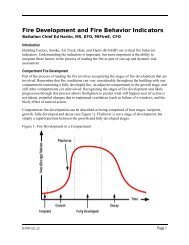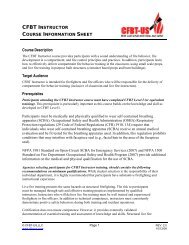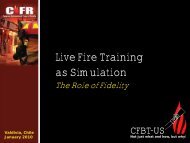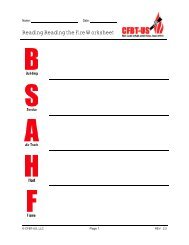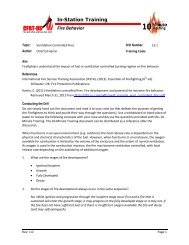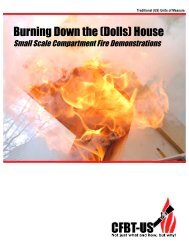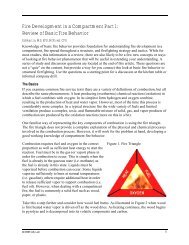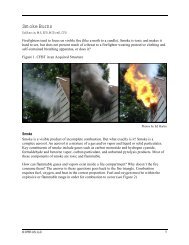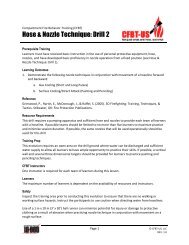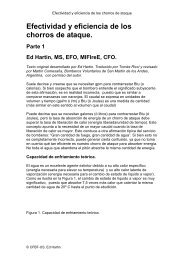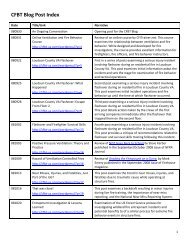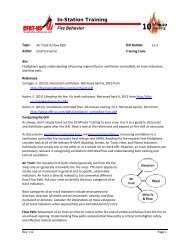Hose & Nozzle Technique: Drill 4 & 5 - CFBT-US!
Hose & Nozzle Technique: Drill 4 & 5 - CFBT-US!
Hose & Nozzle Technique: Drill 4 & 5 - CFBT-US!
You also want an ePaper? Increase the reach of your titles
YUMPU automatically turns print PDFs into web optimized ePapers that Google loves.
Compartment Fire Behavior Training (<strong>CFBT</strong>)<br />
<strong>Hose</strong> & <strong>Nozzle</strong> <strong>Technique</strong>: <strong>Drill</strong> 4 & 5<br />
Prerequisite Training<br />
Learners must have received basic instruction in the use of personal protective equipment, hose,<br />
nozzles, have developed basic proficiency in nozzle operation from a fixed position (see <strong>Hose</strong> & <strong>Nozzle</strong><br />
<strong>Technique</strong>: <strong>Drill</strong> 1), and movement of hoselines coordinated with nozzle operation (see <strong>Hose</strong> & <strong>Nozzle</strong><br />
<strong>Technique</strong>: <strong>Drill</strong>s 2 & 3).<br />
Learning Outcomes<br />
1. Demonstrate the procedure used for safe entry into a compartment that is or may be involved in<br />
fire. This process must include:<br />
a. Size-up (dynamic risk assessment)<br />
b. Door control<br />
c. Gas Cooling<br />
Note: These skills must be demonstrated using both inward opening doors (<strong>Drill</strong> 4) and outward opening<br />
doors (<strong>Drill</strong> 5)<br />
Reference<br />
Grimwood, P., Hartin, E., McDonough, J., & Raffel, S. (2005). 3D firefighting: Training, techniques, &<br />
tactics. Stillwater, OK: Fire Protection Publications.<br />
Resource Requirements<br />
These drills require a pumping apparatus and sufficient hose and nozzles to provide each team of<br />
learners with a hoseline. If possible teams should be limited to no more than five learners to maximize<br />
practice and minimize session duration. If possible, the same nozzles that will be used operationally<br />
should be used for this drill.<br />
Training Prop<br />
Door entry may be practiced using any door where water may be applied (e.g., a burn building or<br />
training tower). However, a free-standing door entry prop is an effective aid in developing proficiency in<br />
door entry.<br />
<strong>CFBT</strong> Instructors<br />
One instructor is required for each team of learners during this lesson.<br />
Learners<br />
The maximum number of learners is dependent on the availability of resources and instructors.<br />
Safety<br />
Inspect the training area prior to conducting this evolution to ensure that there are no walking or<br />
working surface hazards. Instruct the participants to use caution when directing water from hoselines.<br />
Page 1 © <strong>CFBT</strong>-<strong>US</strong>, LLC<br />
REV: 1.0
HOSE AND NOZZLE TECHNIQUE DRILL 3<br />
Personal Protective Equipment<br />
Learners should wear structural firefighting clothing and self-contained breathing apparatus during this<br />
drill.<br />
Scene Control<br />
Scene control will vary to some extent based on the specific training location. The immediate training<br />
area will be limited to participants and (accompanied) observers of the training activity.<br />
If in-service apparatus is at the training location, position it to ensure ease of egress.<br />
Instructional Activities<br />
This lesson involves the following instructional activities. Base your instructional approach on learners<br />
experience level and understanding as the lesson progresses. <strong>Drill</strong>s 4 and 5 are not sequence dependent<br />
(learners may start with either inward or outward opening doors)<br />
<strong>Drill</strong> 4: Inward Opening Doors<br />
1. Review the sequence of actions in the door entry procedure. If learners master the sequence<br />
before engaging in physical practice they can focus on technique rather than both sequence and<br />
technique.<br />
a. Size-Up (approaching and at the door)<br />
b. Control the door. Discuss use of a hose strap to control inward opening doors.<br />
c. Two pulses above and open the door, assess conditions inside, and cool the gases inside<br />
the compartment (short or long pulses depending on the compartment and conditions)<br />
d. Close the door and assess the risk of entry<br />
e. Two pulses above the door and make entry if safe to do so.<br />
It may be necessary to repeat this procedure multiple times to gain control of the space<br />
inside the door.<br />
2. Have the learners verbalize the sequence while walking through the procedure (no hose, nozzle<br />
or door). This helps the learners master the sequence of steps. Reinforce that this is not a lockstep<br />
procedure, the extent to which the door is opened, angle of the fog pattern, and duration<br />
and number of pulses will vary depending on conditions.<br />
3. Have the learners practice the door entry procedure working in both the nozzle and door<br />
position. Provide the learners with information about observed conditions, changing conditions<br />
each time that they perform the procedure.<br />
a. Size-Up (approaching and at the door). Have the learners verbalize their thought process<br />
as they perform this element of the door entry procedure.<br />
b. Control the door. Have the learners practice using a hose strap to control inward<br />
opening doors.<br />
c. Two pulses above and open the door, assess conditions inside, and cool the gases inside<br />
the compartment (short or long pulses depending on the compartment and conditions).<br />
d. Close the door and assess the risk of entry<br />
Page 2 © <strong>CFBT</strong>-<strong>US</strong>, LLC<br />
REV: 1.0
HOSE AND NOZZLE TECHNIQUE DRILL 3<br />
e. Two pulses above the door and make entry if safe to do so.<br />
It may be necessary to repeat this procedure multiple times to gain control of the space<br />
inside the door. Provide varied conditions so that the learners must make this decision.<br />
4. Debrief the learners after each evolution, encourage them to analyze their own performance<br />
and identify how their door entry procedure could have been improved.<br />
<strong>Drill</strong> 5: Outward Opening Doors<br />
This drill is quite similar to <strong>Drill</strong> 4, but using an outward opening door. The principal difference is in how<br />
the learners control the door (a hose strap is not required). Have the learners in the door position<br />
experiment with body and foot position to maintain door control during the door entry procedure.<br />
Integration<br />
<strong>Hose</strong> and <strong>Nozzle</strong> <strong>Technique</strong> <strong>Drill</strong>s 3 and 4 can be used as a stand-alone training exercise or elements of<br />
this drill can be integrated into other training activity. This drill should be integrated into training activity<br />
any time that learners are making entry through a door that may have hot smoke or flames behind it<br />
(e.g., hose evolutions simulating interior fire attack, primary search).<br />
Page 3 © <strong>CFBT</strong>-<strong>US</strong>, LLC<br />
REV: 1.0




